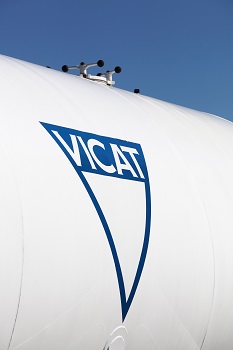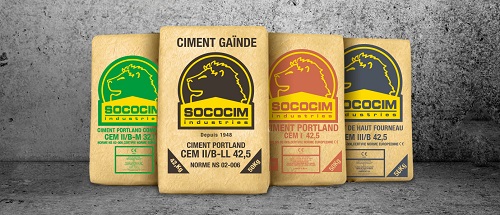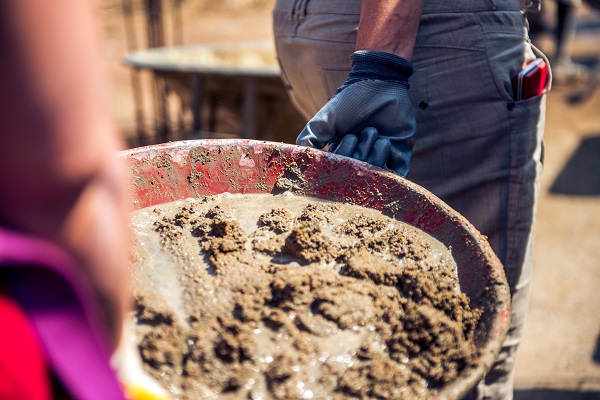
世界水泥制造商正在努力十rbonise the industry. As ABI contributing editorShem Oirerehighlights, many West African producers are playing their part in creating a greener cement future.
The global cement industry has been ranked by the United Nations Environment Programme (UNEP) second, after electricity power generation, in CO2 gas emissions, a challenge cement makers are lately tackling through embracing alternative fuels to power their cement production plants as well as modernising clinker lines to cut down on energy consumption.

UNEP says that in addition to consuming huge volumes of natural resources such as limestone and sand, the world's cement industry also requires an estimated 60-130kg of fuel oil and 110 kWh of electricity to produce a tonne of cement.
"Producing one tonne of portland cement releases roughly one tonne of CO2 to the atmosphere, and sometimes much more, and the cement industry accounts for seven to eight per cent of the planet's human-produced CO2 emissions," UNEP says.
The UN environmental agency says 50% of the emissions come from the production of clinker, 40% from burning fuel and 10% from electricity use and transport.
The concrete industry, UNEP adds, uses approximately 1.6 billion tonnes of portland cement to produce an estimated 12 billion tonnes of concrete annually.
According to the Global Cement and Concrete Association (GCCA), the cement and concrete industry currently accounts for up to 7% of global CO2 emissions despite the latest verified data indicating a 22% CO2 reduction per tonne of cement-based products since 1990, with a 2% drop in 2021.
GCCA projects an increase in concrete production from the current 14 billion m³ to approximately 20 billion m³ by 2050 with associated CO2 emissions, assuming current practice, estimated to reach 3.8 gigatonnes.

Energy consumption by the cement industry is approximately 60% of total cement production costs with the cost of thermal energy, in particular, assumed to be 40% of these costs.
Each tonne of clinker produced is estimated to consume an estimated 3.2 to 4.2 gigajoules although it varies based on the process of production used, with the dry process touted as the most efficient.
However, there is an emerging trend in the global cement industry to cut down on thermal fuel costs by replacing them with lower-cost alternative fuels, especially those derived from waste streams such as plastic, biomass, tyres, and solid industrial and household waste.
过去的世界银行的一份报告称,许多水泥multinationals with a global network of manufacturing plants use approximately 60% of alternative fuels in cement production.
In Africa, some cement manufacturers are responding to the push for greener options in cement manufacturing by launching various interventions focusing largely on upgrading clinker production technology and using alternative fuels to reduce CO2 gas emissions.
West Africa, one of the top regional cement markets in the continent, expects an increase in clinker and cement driven by a fast-growing construction sector.

Statistics by market consultancy firm Deloitte show that in 2021, there were 153 concrete-consuming projects underway in West Africa, 43.7% of them in the transport sector, with a combined value of more than US$172.8 billion. The construction is fuelling demand for cement, which triggers huge consumption of clinker, the leading CO2 gas emitting product.
West Africa's cement market is dominated by Nigeria, Ghana and Senegal, although there are other smaller cement-producing countries such as Mauritania, Benin and Togo.
In Senegal, where the largest national cement market share is held by Sococim Industries, a subsidiary of French cement maker Vicat SA, Dangote and Ciments du Sahel, a new intervention to reduce CO2 gas emissions through increased use of alternative fuels in cement production has been cited as the best alternative going forward for greening West Africa's cement industry.
The three cement producers near the country's capital, Dakar, are currently using the dry process and cyclone preheater technology in cement production. The companies rely on thermal energy sourced from coal imported from Southern Africa, particularly Mozambique and South Africa, to power their manufacturing plants.
Moreover, Sococim is also building a new $286.4 million kiln line to boost the company's clinker capacity in West Africa and improve its industrial performance, particularly in Senegal, one of its key markets. The new production facility is scheduled for commissioning in mid-2024.
在2023年第一季度,Sococim父company, Vicat Group, arranged $235.8 million in financing to fund the subsidiary's clinker equipment modernisation and construction of a new kiln.
The total financing is $266.6 million, made of two tranches of a 10-year $132.2 million tranche granted by the International Finance Corporation (IFC) and a 6-year CFA80 million ($134,729) fixed-rate tranche syndicated by the IFC to a pool of local lenders.
Part of the financing will provide refinancing for Sococim and extend the maturity of its $30.8 million in borrowings.
"Given the performance of the project currently under construction, which will use best-in-class technologies to achieve a carbon intensity of 460 kg gross/per tonne in CO2 emissions, the portion related to this project qualified as "green financing" based on a 'Second Party Opinion' issued by a top-tier agency," said Vicat Group in a statement in February 2023.

According to IFC, the new funds will "boost energy efficiency and maximise alternative fuels in its clinker production plant in Dakar, reducing greenhouse gas emissions by more than 300,000 tons of CO2 equivalent per year by 2030."
IFC added: "Decarbonising heavy industry will require deploying new technologies and substituting fossil fuels with greener energy sources such as biomass, municipal solid waste, and solar and wind energy."
Vicat Group says that despite the African cement market remaining resilient in the face of the effects of inflation and the political crisis in countries such as Mali, the factors constrained Sococim's performance in West Africa.
"In the Cement business, operational sales in the Africa region fell –2.1% at constant scope and exchange rates," the company says in its 2022 full-year report released earlier this year.
"While business trends picked up in Senegal and improved significantly in Mauritania, these factors did not fully offset the sharp contraction in Mali's market as a result of the political environment," it added.
The report says that although cement selling prices rose in Mauritania and Senegal, the increase was not sufficient "to make up for the impact of the cost inflation observed in the region, particularly due to the selling price controls introduced by the Senegalese authorities."
"In Senegal, the Aggregates business, supported by the gradual resumption of major government construction projects, recorded operational sales of €38 million, up +28.2% at constant scope and exchange rates," Vicat adds.

Overall, volumes in Senegal grew sharply in 2022 "while selling prices fell due to an unfavourable product and customer mix."
Reducing the cost of energy through the use of alternative fuel and modernisation of clinker processing technology could support cement companies not only to improve their bottom line but also to support the drive to reach net zero emissions by 2050.
For example, IFC cites Dangote Cement as one of the cement market players in West Africa that is already "making the transition by developing cheaper, cleaner, and more efficient ways to power their factories and conserve natural resources."
Dangote is the third biggest cement company in Senegal, with an estimated annual output capacity of 1.5 million tons, 12% of the country's cement market share, after Sococim's 3.5 million tons and Ciments du Sahel's 2.5 million tons.
The three cement companies produce an estimated 5.1 million tons of clinker annually, with Ciments du Sahel having the lion's share of 41.2% ahead of Sococim's and Dangote's 35.3% and 23.5%, respectively. Their annual thermal energy demand is estimated at 18.6 gigajoules, with Ciment's demand of 7.7 gigajoules, equivalent to 41.4% of the total demand, being the highest. Sococim and Dangote demand is estimated at 6.4 gigajoules and 4.5 gigajoules, respectively.
Dangote, which has operations in at least 10 African markets, has reported huge strides in reducing or replacing thermal energy as the source of powering operations at its cement manufacturing plants.
With retail diesel prices in 2022 having exceeded that of petrol largely due to the higher international refined diesel prices linked to the Russian invasion of Ukraine, Dangote opted for increased utilisation of alternative fuel in cement production. These included co-processing agro wastes, waste lubricants, tyre-derived fuels, sawdust, and packaging materials.
Dangote Cement, which produced an estimated 27.8 million tons of cement in 2022 and reported revenues of ₦1,618.3 billion ($3.5 billion), said it achieved an alternative fuel thermal substitution rate of 4.3% compared to 2.6% in 2021.
The company, which exported 1.58 million tons of cement in 2022 with a profit after tax of ₦382.3bn (US$830 million), had, by December 2022, seen the thermal substitution rate climb to 7.5% with more than 157,000 tons of waste having been co-processed in 2022, an equivalent of 76% increase compared to 2021.
Similar interventions, albeit at varying levels, are ongoing as the other cement companies active in the West Africa market, such as Heidelberg Cement, Holcim (formerly LafargeHolcim), CIMAF, WACEM, BUA and Limak, endeavour to green their cement manufacturing processes in line with the Global Cement and Concrete Association's 2050 Net Zero Roadmap.

The Association, which represents up to 80% of the global concrete industry outside of China, says the roadmap "sets out in detail how collectively, in collaboration with built environment stakeholders and policymakers, we will fully decarbonise the cement and concrete industry and provide net zero concrete for the world."
For example, Heidelberg Materials, a German multinational building materials company whose operations in West Africa are largely domiciled in Benin, Ghana, Guinea-Bissau, Sierra Leone and Togo, says it has in place initiatives to reduce CO2 to achieve "carbon neutrality by 2050 at the latest."
The company's overall global operations reported a reduction of its specific net CO2 target by 22% from the 1990 baseline.
"We are the first cement company to receive confirmation from Science Based Targets initiative (SBTi) that our CO2 reduction target is in line with the goal of Paris Agreement – to limit global warming to below 2°C," the company says of its global operations, including in its West Africa markets.
Elsewhere, Holcim, the Swiss multinational that has operations in Nigeria, Benin, Guinea, Ghana, Ivory Coast and Cameroon, could slowly transform the West Africa clinker market with its new clinker recycling technology that was first unveiled in June 2022 at the company's Altkirch plant in France.
Holcim says it recycled an estimated 54 million tons of materials across its operations in 2021 and "is doubling down on this rate to reach 100 million tons by 2030."
"We recycled 6.6 million tons of construction and demolition waste in 2021 and are scaling up to recycle 10 million tons by 2025," the company says on its website.
In 2022, Holcim says it reduced its CO2 emissions per unit of net sales by over 20%, "and we will lower them by over 10 per cent in 2023," according to the company's CEO Jan Jenisch.

"In 2022, we achieved key green growth milestones, from our low-carbon concrete ECOPact reaching 13 per cent of ready-mix net sales to scaling up ECOPlanet low-carbon cement in 27 markets," he said.
Although he did not list the 27 markets, it's expected that the six West African markets where the company operates could be among those targeted with the new sustainability interventions.
Meanwhile, in Ghana, Denmark's State-owned Investment Fund for Developing Countries (IFU) is investing in a new cement plant in Ghana that will reduce CO2 emissions by up to 20% per ton of cement produced.
IFU and Norfund, a Norwegian development finance institution, have recently partnered with CBI Ghana Ltd, the producer of Supacem Cement, to construct the world's largest calcined clay cement plant.
Other $80 million project partners include CBI Ghana Ltd's parent company F. Scott, Societe Generale and EKF Denmark. The 405,000-ton-per-annum plant has been sited at the Tema Free Zones Enclave.
Danish multinational technology company FLSmidth & Co. A/S is providing new technology that would make it possible to substitute clinker with calcined clay.
CBI Ghana Ltd CEO Frédéric Albrecht previously said lack of suitable limestone reserves in West Africa makes using clay as an alternative to clinker the most sustainable alternative to traditional clinker-based cement.
In its 2022 Africa Construction Trends report, Global professional services provider Deloitte said approximately 153 concrete-consuming projects are underway in the West Africa region, the highest on the continent, 43.7% in the transport sector.
The infrastructure and capital projects valued at $50m that had broken ground but had not yet been commissioned by 1 June 2021 were valued at $172.8 billion.
These construction projects drive increased demand for cement in West Africa, hence the pressure to have alternative energy sources to power cement manufacturing plants.
Yet, as the International Energy Agency (IEA), a Paris-based independent intergovernmental organisation, providing policy recommendations, analysis and data on the global energy sector, says reducing "CO2 emissions while producing enough cement to meet demand will be challenging."















